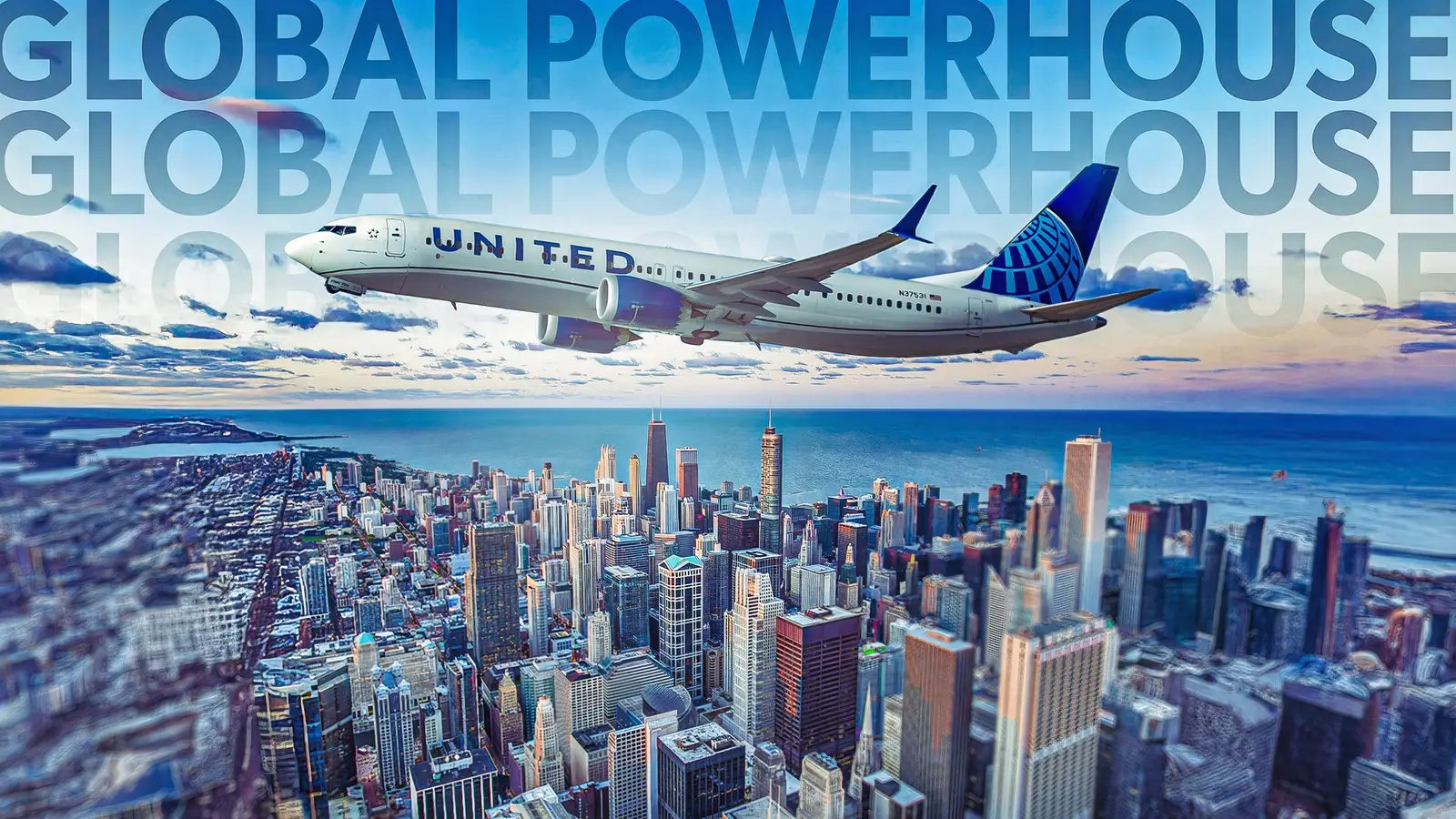
Chicago O’Hare International Airport(ORD) is one of the busiest and most strategic airports in the world, and no airline has shaped its destiny more than United Airlines. Over the decades, United transformed O’Hare from a regional facility into a truly global powerhouse. In this guide, we’ll trace how United built its fortress hub, the strategies behind its growth, the competitive battles it fought, and what lies ahead for its O’Hare operation. Readers can expect a deep dive into history, data, and industry insight, supported by examples and context from United’s official fact sheets, airline historians, and aviation communities.
United Airlines and O’Hare are almost synonymous in aviation. As the largest carrier at ORD, United operates more than 450 daily departures to over 160 destinations worldwide. This hub is not just a home base; it is the beating heart of United’s global network, supporting both domestic dominance and intercontinental reach. Understanding how United grew its ORD presence, outnumbering its main rival – American Airlines, which also considers this airport its hub, provides a window into the evolution of US aviation itself, from the postwar jet age to the modern competitive landscape.
The Historical Rise Of United At O’Hare
United’s origins in Chicago date back to the earliest years of commercial aviation. According to the United Airlines Historical Foundation, the company’s lineage stretches back to Varney Air Lines in the 1920s and the consolidation of multiple carriers into United Air Lines in 1931. By the 1950s, United was already entrenched in Chicago’s Midway Airport before shifting its primary operations to the newly constructed O’Hare in 1955.
The move to O’Hare was transformative. The new airport offered longer runways, jet-age facilities, and room to grow. United invested heavily, making ORD its largest hub. Over the decades, ORD became the stage for some of the most intense battles in US airline history, particularly between United and American Airlines in the 1980s and 1990s. As Reddit users note in discussions of ORD’s evolution, United ultimately gained the upper hand, consolidating dominance as American reduced its footprint.
United’s strategy was simple but effective: prioritize scale, connectivity, and operational reliability. The airline’s hub-and-spoke model at ORD allowed it to funnel millions of passengers through Chicago annually, cementing the city’s status as a global aviation crossroads.
Competition And Consolidation: United Vs American
United’s rise at ORD cannot be understood without acknowledging its competition with American Airlines. For decades, the two carriers fought a bitter battle for market share in Chicago. American built its own stronghold in Terminal 3 and, for a time, rivaled United’s dominance. However, financial struggles, bankruptcy, and strategic shifts led American to scale back its ORD ambitions.
As noted by the infographics from United’s Reddit thread below, this retreat left United with unparalleled dominance at ORD. Today, American maintains a significant presence but operates fewer flights and destinations than United. This competitive advantage allows United to better control schedules, pricing, and passenger flows through O’Hare.
United now accounts for the majority of O’Hare’s departures, seats, and destinations, making ORD its flagship hub in both scale and revenue.
O’Hare As United’s Global Gateway
Chicago O’Hare (ORD) is not only United’s largest hub but its primary international gateway. United’s own airport fact sheet reports that, together with United Express, the airline operates roughly 560 daily flights out of O’Hare, and 45 daily nonstop flights to 39 international destinations, according to the United Media Center, evidence of how ORD underpins United’s global network.
United’s international footprint at ORD spans Europe, Asia-Pacific, Canada, and Latin America. The city’s geographic midpoint between coasts (and relatively efficient polar routing to Asia) makes ORD a logical launch point for long-haul flying, while United’s alliance ties multiply onward connections. To support this, O’Hare’s redevelopment program (O’Hare 21 / ORDNext, as described on the ORD news page) includes a planned Global Terminal and new satellite concourses that will improve transfer flows, add gates, and expand international processing, exactly the sort of infrastructure United needs for higher long-haul throughput.
Source: flychicago.com
United’s international dominance at ORD reflects strategic choices made over decades. Chicago’s geography is uniquely advantageous, sitting almost equidistant between the US coasts and Europe, while also providing an efficient routing toward Asia over the Arctic. This positioning, combined with United’s deep alliance integration, has made ORD a cornerstone of its global network. For passengers, this means that O’Hare is not just a transfer point but a genuine bridge between continents, shaping how United competes against both domestic rivals and international carriers.
Infrastructure And Expansion At ORD
United’s powerhouse position at Chicago O’Hare (ORD) is deeply tied to the airport’s infrastructure. Terminal 1, famously known as the “United Terminal,” was completed in 1987 as part of the airport’s ambitious $1 billion redevelopment project. Designed by Helmut Jahn, it remains one of the most recognizable passenger terminals in the world, with its neon-lit underground walkway connecting Concourses B and C becoming a symbol of modern air travel in Chicago. The terminal layout was deliberately designed to optimize hub-and-spoke connectivity, giving United the ability to efficiently route passengers through its growing domestic and international network.
Over the years, United has continuously reinvested in its ORD base to stay competitive. The O’Hare 21 modernization project, one of the largest airport redevelopment programs in the United States, is central to the airline’s long-term strategy. Expansion plans include dozens of new gates, redesigned concourses, state-of-the-art lounges, and a Global Terminal that will streamline international connections. For United, these improvements are more than cosmetic as they directly support the airline’s growth in international markets, particularly transatlantic and transpacific routes.
These fleet decisions align perfectly with ORD’s expansion: widebodies dominate the growing long-haul portfolio, while narrowbodies maintain dense domestic feed. The synergy between terminal upgrades and aircraft strategy reinforces O’Hare as not just a United hub, but one of the most globally connected airports.
Economic And Community Impact
O’Hare is not only a hub for travelers but also an economic engine that drives Chicago and the state of Illinois. United employs tens of thousands of people in the region, with ORD operations supporting jobs in aviation, hospitality, and logistics. The United Airlines Historical Foundation notes that Chicago has been the airline’s corporate hometown for decades, further strengthening ties between the company and the local community.
Passengers traveling through ORD experience the scale of United’s operations firsthand. Terminal 1 is home to United’s Polaris Lounge, and United Clubs, and efficient security screening lanes designed to handle high passenger volumes. United has also invested in biometric screening and mobile app integration to streamline the journey.
For connecting passengers, ORD’s central location is a major advantage. The hub’s connectivity allows passengers to link domestic and international itineraries with minimal layover times. This has been a key factor in making ORD attractive to both business and leisure travelers.
The Road Ahead: ORD’s Next Era With United
Looking ahead, United’s ORD strategy is focused on modernization and sustainability. Expansion projects at O’Hare, including new runways and terminal upgrades, will support United’s growth.
The airline is also investing in fleet renewal, with Boeing 787s and Airbus A321XLRs set to strengthen ORD’s international and domestic connectivity.
Ultimately, United’s dominance at O’Hare reflects a century-long partnership between airline and city. From its origins in the 1940s to today’s global powerhouse, ORD remains United’s beating heart and a vital hub in the world’s aviation system.



